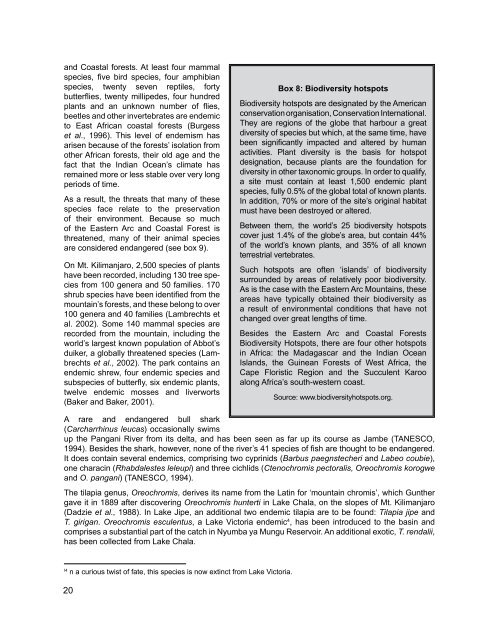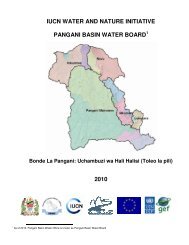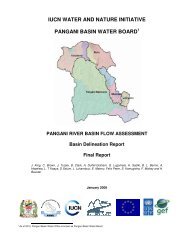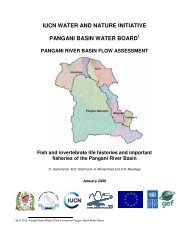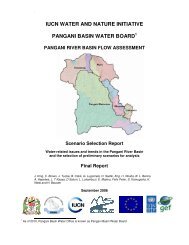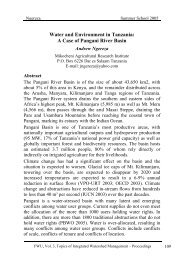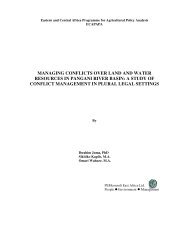PANGANI BASIN WATER BOARD
PANGANI BASIN WATER BOARD
PANGANI BASIN WATER BOARD
You also want an ePaper? Increase the reach of your titles
YUMPU automatically turns print PDFs into web optimized ePapers that Google loves.
and Coastal forests. At least four mammal<br />
species, five bird species, four amphibian<br />
species, twenty seven reptiles, forty<br />
butterflies, twenty millipedes, four hundred<br />
plants and an unknown number of flies,<br />
beetles and other invertebrates are endemic<br />
to East African coastal forests (Burgess<br />
et al., 1996). This level of endemism has<br />
arisen because of the forests’ isolation from<br />
other African forests, their old age and the<br />
fact that the Indian Ocean’s climate has<br />
remained more or less stable over very long<br />
periods of time.<br />
As a result, the threats that many of these<br />
species face relate to the preservation<br />
of their environment. Because so much<br />
of the Eastern Arc and Coastal Forest is<br />
threatened, many of their animal species<br />
are considered endangered (see box 9).<br />
On Mt. Kilimanjaro, 2,500 species of plants<br />
have been recorded, including 130 tree species<br />
from 100 genera and 50 families. 170<br />
shrub species have been identified from the<br />
mountain’s forests, and these belong to over<br />
100 genera and 40 families (Lambrechts et<br />
al. 2002). Some 140 mammal species are<br />
recorded from the mountain, including the<br />
world’s largest known population of Abbot’s<br />
duiker, a globally threatened species (Lambrechts<br />
et al., 2002). The park contains an<br />
endemic shrew, four endemic species and<br />
subspecies of butterfly, six endemic plants,<br />
twelve endemic mosses and liverworts<br />
(Baker and Baker, 2001).<br />
Box 8: Biodiversity hotspots<br />
Biodiversity hotspots are designated by the American<br />
conservation organisation, Conservation International.<br />
They are regions of the globe that harbour a great<br />
diversity of species but which, at the same time, have<br />
been significantly impacted and altered by human<br />
activities. Plant diversity is the basis for hotspot<br />
designation, because plants are the foundation for<br />
diversity in other taxonomic groups. In order to qualify,<br />
a site must contain at least 1,500 endemic plant<br />
species, fully 0.5% of the global total of known plants.<br />
In addition, 70% or more of the site’s original habitat<br />
must have been destroyed or altered.<br />
Between them, the world’s 25 biodiversity hotspots<br />
cover just 1.4% of the globe’s area, but contain 44%<br />
of the world’s known plants, and 35% of all known<br />
terrestrial vertebrates.<br />
Such hotspots are often ‘islands’ of biodiversity<br />
surrounded by areas of relatively poor biodiversity.<br />
As is the case with the Eastern Arc Mountains, these<br />
areas have typically obtained their biodiversity as<br />
a result of environmental conditions that have not<br />
changed over great lengths of time.<br />
Besides the Eastern Arc and Coastal Forests<br />
Biodiversity Hotspots, there are four other hotspots<br />
in Africa: the Madagascar and the Indian Ocean<br />
Islands, the Guinean Forests of West Africa, the<br />
Cape Floristic Region and the Succulent Karoo<br />
along Africa’s south-western coast.<br />
Source: www.biodiversityhotspots.org.<br />
A rare and endangered bull shark<br />
(Carcharrhinus leucas) occasionally swims<br />
up the Pangani River from its delta, and has been seen as far up its course as Jambe (TANESCO,<br />
1994). Besides the shark, however, none of the river’s 41 species of fish are thought to be endangered.<br />
It does contain several endemics, comprising two cyprinids (Barbus paegnstecheri and Labeo coubie),<br />
one characin (Rhabdalestes leleupi) and three cichlids (Ctenochromis pectoralis, Oreochromis korogwe<br />
and O. pangani) (TANESCO, 1994).<br />
The tilapia genus, Oreochromis, derives its name from the Latin for ‘mountain chromis’, which Gunther<br />
gave it in 1889 after discovering Oreochromis hunterti in Lake Chala, on the slopes of Mt. Kilimanjaro<br />
(Dadzie et al., 1988). In Lake Jipe, an additional two endemic tilapia are to be found: Tilapia jipe and<br />
T. girigan. Oreochromis esculentus, a Lake Victoria endemic 4 , has been introduced to the basin and<br />
comprises a substantial part of the catch in Nyumba ya Mungu Reservoir. An additional exotic, T. rendalii,<br />
has been collected from Lake Chala.<br />
I4<br />
n a curious twist of fate, this species is now extinct from Lake Victoria.<br />
20


